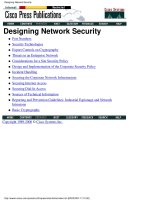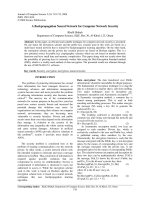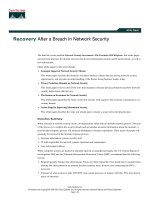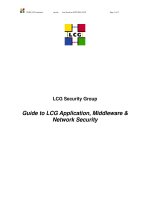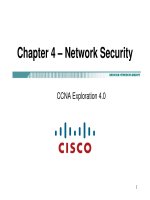Guide to LCG Application, Middleware & Network Security doc
Bạn đang xem bản rút gọn của tài liệu. Xem và tải ngay bản đầy đủ của tài liệu tại đây (1.32 MB, 13 trang )
CERN-LCG-reference version Last Saved on 02/07/2004 18:20 Page 1 of 13
LCG Security Group
Guide to LCG Application, Middleware &
Network Security
CERN-LCG-reference version Last Saved on 02/07/2004 18:20 Page 2 of 13
Date: 2
nd
July 2004
EDMS Reference:
Internal Version: 1.6
Status: draft
Author: Ian Neilson
CERN-LCG-reference version Last Saved on 02/07/2004 18:20 Page 3 of 13
Document Log
Issue Date Author Comment
1.0 5
th
March Ian Neilson Initial Version
1.1 27
th
May Ian Neilson Incorporate comments from LCG Sec.
Group.
1.2 1
st
June Ian Neilson Comments from Dane Skow
1.3 2
nd
June Ian Neilson Further comments from Dane Skow
1.4 7
th
June Ian Neilson Comments from 4th June phone conf.
1.5 1
st
July Ian Neilson Updated port table
1.6 2
nd
July Ian Neilson Change title and comments from Sec.
Group meeting 1
st
July
CERN-LCG-reference version Last Saved on 02/07/2004 18:20 Page 4 of 13
1 Introduction
This document identifies areas of security practice which the LCG
1
Security Group and the Grid
Deployment Board consider must be addressed in application and middleware design, planning and
deployment processes where such software is to be used by or on the LCG.
The LCG Security and Availability Policy
2
states that
“All the requirements for the networking security of LCG Resources are expected to be
adequately covered by each site’s local security policies and practices”.
This document also seeks to identify and clarify issues where local security policy and LCG
security policy must be aligned.
1.1 The shortest introduction to the Grid
Very brief descriptions of the grid architecture and services are included in this document in the
hope of making it accessible to non-grid-specialist administrators who may be involved in the
deployment of grid services at a site.
Conceptually, the grid consists of a number of connected sites which offer resources to remote
users across the internet. The resources offered by a site (resource-provider) are exposed through
interfaces implemented by a number of software grid-services executing on computers on the site
network (grid-service nodes). Grid-services, as well as offering functionality directly to users, also
serve peer services resulting in a complex web of network interdependencies. The location and
characteristics of services and offered resources are registered in an information system, itself
implemented by a number of service nodes across the grid. Some further details of common grid
services are available in Appendix A.
The Grid is a highly dynamic environment. The standards governing grid services are currently
being defined and software implementations are subject to revision. The resources available are
continually being expanded and changing in configuration. The user community is geographically
widely distributed and volatile. Managing security in this environment, whilst retaining the desired
level of accessibility for users is a challenge for software designers, implementers and site
administrators.
2 Application, Middleware and Service Development
LCG is a collaboration to deploy a production environment of interoperable grid services. As such,
LCG expects that the development processes employed by projects whose software LCG deploys
will support an adequate and well-documented treatment of security.
The grid environment is highly distributed. An area where current application software
requirements and their usage patterns can be misaligned with site security policies is an assumption
of the availability of IP network connectivity from anywhere to anywhere. The result of this
assumption can be a weakening of site network access control measures and consequent increased
likelihood of sites being subject to network attacks from the outside or being used as the source of
an outbound attack on a third party. The latter case would be particularly severe if a distributed
denial of service attack were to be mounted from a large farm of grid nodes. For this reason sites
may choose to restrict both incoming and outgoing network packets at the site boundary or place
resources on non-routable internal networks. Solutions taken by system administrators to protect
their resources could result in limitations to bandwidth and reliability if not properly planned. The
LCG Security Group strongly recommends that application developers, virtual organisations and
1
Large Hadron Collider Computing Grid –
2
Security and Availability Policy for LCG -
CERN-LCG-reference version Last Saved on 02/07/2004 18:20 Page 5 of 13
users minimise and structure network connectivity required in their use of resources. Segregating
traffic among a well identified and specifiable set of resources enables effective monitoring and
access control to be deployed.
Appendix B describes the current connectivity assumptions of commonly deployed grid software
used in LCG. The LCG Security Group considers these assumptions to be inappropriate for
deploying a production grid and recommends that developers and designers develop ways to more
effectively constrain the required access of future systems. Specifically, whilst application
developers MUST NOT rely on the availability of any connectivity not specified in this
document, that described in Appendix B should also NOT be read as an agreed minimal set.
For instance, by requiring that network communications pass into and out of a site through one or
more recognised grid service nodes or other service proxies, these nodes can act as managed
gateways between internal resources and external services and be protected by appropriately
configured access control measures and monitoring tools.
Detailed guidance on best practice for software development is outside the scope of this document
but the LCG Security Group considers that, as a minimum, the following practices should always
be observed.
2.1 Design and development process
• Evaluate and document the risks in the current and foreseen threat environment before
starting and concentrate effort where the risk is highest.
Prioritising risks early in the development process and ensuring that appropriate control
points and mitigating measures are fed into the requirements gathering process will assist in
ensuring that the final application usability and security are not compromised by a narrow
focus on functionality or performance.
• Adhere to the published practices of the development project. This should ensure, at
minimum, a consistent and maintainable product on which to build application security.
Projects should apply a development methodology appropriate to the requirements. Neither
a classic waterfall nor agile development process is appropriate in all cases. A consistency
of approach ensures that design documents and code are easily accessible to all members of
the project. This facilitates activities such as design review and code walk-through during
the development cycle and enables traceability and debugging of problems during testing
and eventual deployment. Care should be taken to ensure that configuration instructions are
accurate and complete as this is a common area where otherwise secure systems are left
vulnerable.
• Apply principle of least privilege.
Implementing a policy with levels of authorization can assist in maintaining the integrity of
services and data under attack and limit damage due to software failure or unintentional use.
At its simplest this could be written as “don’t run all services as the root user”.
2.2 Coding practice
• Code for clarity first and optimise during testing if necessary.
Complexity is the enemy of security. Well-structured, clear code allows for better
understanding of intent and appropriate algorithms. It also reduces the likelihood of the
introduction of errors which may lead to security problems.
• Reuse tested code where possible.
CERN-LCG-reference version Last Saved on 02/07/2004 18:20 Page 6 of 13
Software which has been subjected to extended analysis and use is less likely to have
exploitable security holes than new software.
• Test all applications for function and fault conditions. Do not assume friendly inputs.
Even if communications are authenticated and integrity is assured, preventing exploit of
buffer overflows and parsing errors limits the propagation of a local security failure across
the network.
• Document external code dependencies and include these in the packaging if possible.
Correct behaviour of software usually depends on the build environment and a large number
of external components. Wherever possible the development and packaging should actively
prevent an insecure deployment by dependency management. However, it should be noted
that overly strict and detailed dependency specification may lead to restrictions in
upgradeability. For instance, it should not be required that the version number of a shared
library is exactly equal to the version with a critical security bug fix, but rather, equal or
greater.
2.3 Communications security
• All network communications should be authenticated and integrity checked. (GSS API
3
,
GSI API)
Ensuring that communicating parties are trusted (or at least known) and that
communications are not altered makes it much harder for malicious or accidental behaviour
to damage the system without being traceable to a cause.
• Any network communication containing sensitive or personal data should be encrypted.
Whilst the design process must take account of varying legal requirements related to the
storage and communication of personal information, identity theft and inappropriate or
illegal use of the information gathered from communications across an insecure network
remains a possibility if such details are transmitted as clear-text.
• Do not invent new protocols when existing ones can be used.
It is often tempting to assume that for performance or other reasons an application requires a
new or modified protocol to be developed. Experience shows that this is usually not the case
and existing standards, which have been open to study and use over an extended period of
time, avoid the many subtle failures that can be induced in the development of security
protocols.
2.4 Functional security
• All use of resources should be appropriately authorized.
By deployment of appropriate access control points the system should be designed to ensure
that only properly authorized use is made of resources (compute, storage, network etc.).
• Degrade and fail gracefully and with meaningful error reporting.
When an error occurs (e.g. due to lack of resources, loss of network or communication),
determining the cause of the problem and subsequent corrective action is greatly assisted by
appropriate predictable behaviour and logging. This is particularly so in a distributed
environment where failure patterns can be complex, loosely coupled and poorly
reproducible making early capture of the necessary information critical. Failure may be
3
Generic Security Service API -
CERN-LCG-reference version Last Saved on 02/07/2004 18:20 Page 7 of 13
deliberately induced as part of an attack and the system should consequently be designed to
remain stable, controllable and secure in all states.
• Log security “state” transitions: connected, authenticated, authorized, disconnected.
Security failures will occur and detection and analysis is only possible if appropriate
information is available.
• Avoid leakage of information through temporary files.
The location and naming of temporary files, the manner in which they are created, the
access-rights assigned and their contents can all lead to the inadvertent or malicious
disclosure of information. Similarly, analysis of patterns of communication can lead to
inferences about system usage which effectively disclose restricted information.
3 Application, Middleware and Service Deployment
As with software development, LCG expects that instructions to ensure secure application and
service deployment will be included in the documentation accompanying the products of associated
projects supplying LCG. The LCG Security Group believes at least the following areas should be
addressed by those responsible for service deployment.
• Evaluate and document the risks in the current and foreseen threat environment before
starting and concentrate effort where the risk is highest.
Security risks to be accommodated in deploying software will vary depending on the
circumstances at each site. In some cases the needs of the grid software may be in conflict
with established practice and these issues should be understood and addressed before
deployment begins.
• Establish a clear network access control policy.
It is often the case that the administrators of grid resources are not the same individuals as
those of site access control systems (e.g. firewalls). Consequently, it is important for the
reliability and availability of grid services that the connectivity requirements are properly
communicated and agreed by the network managers. This will reduce the likelihood of ports
being closed unexpectedly and facilitate the proper monitoring of traffic.
The table in Appendix B describes the IP connectivity requirements of current grid software.
Additional guidance for the configuration and use of the Globus Toolkit is available in the
Globus Firewall Requirements
4
document. Currently for LCG, only the sections of this
document applying to Globus Toolkit V2 (GT2) are applicable.
• Apply Configuration Management and automate wherever possible.
There are many interdependencies between the configuration of grid services, the operating
environment and other peer services. The secure deployment of user-level application
software must also be taken into account. Whilst, given sufficient familiarity with the
software, manual configuration of a resource is possible, to assist in the generation of a
reproducible service interface, it is recommended that administrators make use of a
configuration management tool and automate as much of the installation and configuration
as possible. Such automation allows for updates to be deployed in a consistent, timely and
controlled fashion
• Keep systems patched with security updates.
4
Globus Firewall Requirements -
CERN-LCG-reference version Last Saved on 02/07/2004 18:20 Page 8 of 13
The prompt application of security updates reduces the time window during which the
exploit of a known attack is possible.
• Configure & retain audit logs
Retention of logs for purposes of audit is mandated by the LCG Audit Requirements
document
5
. Sufficient information should be retained to enable a complete trace from
resource usage back to initial user authentication. This information can be useful for
troubleshooting purposes and may also be needed in the investigation of security incidents
as described in the Agreement on Incident Response document
6
. Care should be taken to
ensure that the logs gathered are securely archived and the integrity of these archives is
guaranteed and access appropriately restricted.
5
LCG Audit Requirements -
6
Agreement on Incident Response -
CERN-LCG-reference version Last Saved on 02/07/2004 18:20 Page 9 of 13
4 Further Information
There are many excellent references available to support secure software development and
networking. The author recommends the following as recent general texts with further
bibliographies to explore.
a) Secure Coding: Principles and Practice by Graff & van Wyk (O'Reilly, 2003 ISBN 0-596-
00242-4) also www.securecoding.org
b) Practical Unix & Internet Security by Garfinkel, Spafford & Schwartz (3
rd
Edition,
O’Reilly, 2003 ISBN 0-596-00323-4)
c) Firewalls and Internet Security: Repelling the Wily Hacker by Cheswick & Bellovin (2
nd
Edition, Addison-Wesley, 2003 ISBN: 020163466X)
d) Security Engineering by Anderson (John Wiley, 2001 ISBN 0-471-38922-6)
At the time of writing, up-to-date general information on the changing environment of grid security
is harder to find. The Grid, Second Edition edited by Foster & Kesselman (Morgan Kaufmann, 2004
ISBN 1-55860-933-4) contains a slim chapter on the subject. The Globus Project
7
, Global Grid
Forum
8
and other grid project websites can be expected to contain references to the latest
developments.
7
The Globus Project –
8
The Global Grid Forum –
CERN-LCG-reference version Last Saved on 02/07/2004 18:20 Page 10 of 13
Appendix A. Grid Services
The deployment of grid services brings with it new dictionary of acronyms which can make
understanding documentation difficult. The most common LCG service acronyms are described here
and a more extensive collection is maintained by the UK GridPP project here:
/>
CERN-LCG-reference version Last Saved on 02/07/2004 18:20 Page 11 of 13
UI
User Interface
The machine where the user is logged on, submits jobs to RBs or CEs and retrieves
the output.
RB
Resource Broker
Sometimes called the Workload Manager. On receipt of a user’s job request, this
service matches the job requirements to advertised resources and sends the job to the
appropriate place to be run.
CE
Computing Element
A service that acts as an interface between the grid and a site’s resources. It receives
job requests (from an RB or directly from the UI) and manages the running of the
job on a local batch system.
SE
Storage Element
Whilst a job request has some facilities to ‘carry’ small volumes of input and output
data, the SE is used for bulk data storage and retrieval.
BDII
Berkeley Database Information Index
A grid service which forms part of a network of similar service nodes which gather
and publish information about grid resources enabling the discovery of resources
and their capabilities.
WN
Worker Node
A machine in a local batch farm on which jobs are run.
PX
MyProxy Server
A service into which a user stores long-term proxy credentials from which RBs can
renew short-term proxy credentials.
RLS
Replica Location Service
A service which makes available and manages a catalogue of data replica locations.
GRIS
Grid Resource Information Service
A service which publishes information about a resource using the LDAP protocol.
VO
Virtual Organization
A service which publishes VO membership using the LDAP protocol.
CERN-LCG-reference version Last Saved on 02/07/2004 18:20 Page 12 of 13
Appendix B. IP Connectivity Table
The following table gives requirements for IP connectivity for the various grid services. Information in this table is derived from the European
DataGrid Project
9
firewall table.
Note: The most recent version of this table can be obtained here: />
Node Service From To
src
port
(tcp) dest port (tcp) comment
all
ntpd ntp servers 123/udp localhost 123/udp
BDII
LDAP *{RB,UI,WN} * localhost 2170
localhost * *{BDII} 2170
localhost * *{CE,SE} 2135
CE
Globus & EDG Gatekeepers
(GRAM)
*{RB} C localhost 2199
JobManager *{RB} C *{RB} C
GridFTP Control *{UI,SE,CE,WN} C localhost 2811
GridFTP data (single
channel) *{UI,SE,CE,WN} C localhost C
GridFTP data (multiple
channel) *{UI,SE,CE,WN} C localhost C
!! Direction of connection is as for dataflow
localhost C *{UI,SE,CE,WN} C !! Direction of connection is as for dataflow
RB
Logging & Bookkeeping *{UI} C localhost 9000,9001
locallogger (logd) *{CE} * localhost 9002
CondorG *{CE} * localhost 7771
NetworkServer (GRAM) *{UI} C localhost 7772
MySQL localhost * localhost 3306
Modified GridFTP (see CE)
9
European DataGrid project -
CERN-LCG-reference version Last Saved on 02/07/2004 18:20 Page 13 of 13
Node Service From To
src
port
(tcp)
dest port (tcp) comment
PX
MyProxy *{RB,UI} * localhost 7512
RLS
LRC (tomcat) *{RB,UI,WN} * localhost
8080, 9101-
9120
RMC (tomcat) *{RB,UI,WN} * localhost
8080, 9201-
9220
MySQL localhost * localhost 3306
SE
RFIO site{WN} * localhost 3147
GridFTP (see CE)
SRM - httpd(apache) * * localhost 80
GRIS
MDS (LDAP) *{BDII,RB,UI,SE,CE,WN} * localhost 2135
VO
LDAP *{RB,SE,CE} * localhost 389
misc
NFS site{SE,CE,WN} * localhost 2049
Requirement depends on site configuration
portmap site{SE,CE,WN} * localhost
111 (udp &
tcp)
Requirement depends on site configuration
openssh site{CE,WN} * localhost 22
Requirement depends on site configuration
Key:
C
Controlable Ephemeral range (e.g. 20000-25000). Note: In practice, although this port-range is locally
configurable using the GLOBUS_TCP_PORT_RANGE environment variable, the values applying at a remote
service cannot be predicted. Consequently reliable connection can only be established if all ports >1023 are left
open for outbound connections.
